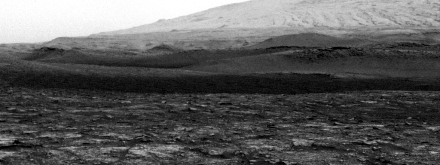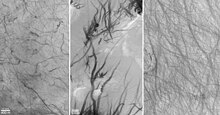Martian dust devils

Martian dust devilsare convectiveatmospheric vorticesthat occur on the surface ofMars.They were discovered from data reported byNASA'sViking probes,and have been photographed by orbiting satellites and surface rovers in subsequent missions.
Although comparable to terrestrialdust devilsin formation and appearance, Martian dust devils can be many times larger than ones found onEarth.They can be powerful enough to pose a threat to rovers and other technology,[1]although some documented encounters have actually benefitted rovers by cleaning them of dust.
Observation[edit]

The existence of dust devils on Mars was confirmed by analysis of data from theVikingprobes in the early 1980s. Photographs from the Viking orbiters revealed tracks across the Martian surface suspected to be caused by dust devils, and data from the landers' meteorological instruments confirmed convective vortices as the cause.[2]Orbital photographs previously taken byMariner 9also showed surface lineations initially thought to be the ridges ofseif dunes,but they were also shown to be dust devil tracks based on the data from Viking.[3]
Martian dust devils have since been detected and photographed by both orbiting satellites and rovers on the surface. TheMars Pathfinderrover detected 79 convective vortices through atmospheric pressure data, and imaged several dust devils with its wide-angle camera.[2]On 7 November 2016, five dust devils ranging in height from 0.5 to 1.9 kilometers were imaged in a single observation by theMars Orbiter Missionin the Martian southern hemisphere.[4]On 27 September 2021, thePerseverance roverdirectly encountered a Martian dust devil, imaging and recording the sound of the vortex as it passed, the first such observation in the history ofMars exploration.[5]
Perseverance Rover recorded a very tall dust devil in the distance on Aug. 30, 2023. It was about 2.5 miles (4 kilometers) away and was moving east to west at about 12 mph (19 kph). Its width was about 200 feet (60 meters). Even though only the bottom 387 feet (118 meters) of the devil was visible in the camera frame, scientists estimated its total height at about 1.2 miles (2 kilometers) based on the length of its shadow[6]---higher than the average tornado on Earth.[7]
Formation and characteristics[edit]
Dust devils on Mars form by the same basic mechanism as ones on Earth; specifically, solar energy heats the Martian surface, causing warm air near the ground to rise through the cooler air above, creating an updraft. Horizontal wind then causes rotation, forming a vortex. The lifting of surface material through the vortex creates a visible dust devil. On average, however, Martian dust devils are about three times as large as their terrestrial counterparts. The largest vortices can reach heights of up to 8 kilometers and widths of up to 700 meters, and last more than 25 minutes.[8][9]The greater height of Martian dust devils may be due to aplanetary boundary layerwhich is several kilometers thicker on average than Earth's.[10]

Dust devils occur very frequently on Mars. One team of researchers have calculated a rate of 1 event persolfor each square kilometer of the Martian surface.[11]
As on Earth, they occur during warmer times of year. Research has revealed highly predictable seasonal behavior, with activity escalating sharply just before Martian vernal equinox, peaking in midsummer, and declining after the autumnal equinox.Amazonis Planitiahas been identified as the region most prone to dust devil activity on Mars.[12]
Dust devils are believed to play an important role in theclimate of Mars.By uplifting large amounts of surface material high above the ground, they may be responsible for as much as 30% of the dust found in the Martian atmosphere, which creates a warming effect and regulates the amount of water vapor in the atmosphere. As they expose lower, darker-colored layers ofregolith,the change in surfacealbedomay alter local climates.[10]
Large dust devils may pose a danger to equipment from Earth.[1]However, some vortices have had beneficial effects. In 2005, theSpirit roverdirectly encountered a dust devil which blew off the dust which had accumulated on the rover's solar panels, dramatically increasing power levels and enhancing research productivity.[13]Sudden, unexpected recovery of power output was also experienced periodically by theOpportunityandSojournerrovers, considerably expanding their operational lifetimes. Dust devils were suspected as the cause of these recoveries.[10]
Tracks[edit]

The tracks left by Martian dust devils are distinguished by their dark, filament-like appearance, although lighter-colored tracks have also been observed.[14]Their patterns reveal several notable trends regarding the behavior of dust devils on Mars. The paths tend to be straight or curvilinear, and can be up to 75 kilometers in length. Tracks generally run from east to west in both hemispheres, although those in the northern hemisphere frequently indicate a northeast-to-southwest orientation.[3]
Surface photography has revealed that track patterns are highly transient due todust stormsand other phenomena which frequently erase the tracks, allowing completely new patterns to form.[15]
See also[edit]
References[edit]
- ^abSmith, Peter; Renno, Nilton (6 June 2001)."Studying Earth Dust Devils For Possible Mars Mission".UniSci News. Archived fromthe originalon 19 April 2012.Retrieved1 December2006.
- ^abRingrose, T.J.; Towner, M.C.; Zarnecki, J.C. (2003)."Viking Lander 1 and 2 revisited: the characterisation and detection of Martian dust devils"(PDF).Sixth International Conference on Mars:3017.Bibcode:2003mars.conf.3017R– via Lunar and Planetary Institute.
- ^abGrant, John A.; Schultz, Peter H. (11 October 1985)."Possible Tornado-like Tracks on Mars".Science.237(4187): 883–885.doi:10.1126/science.237.4817.883.JSTOR1699893.PMID17771377.S2CID38437445– via JSTOR.
- ^Singh, Ramdayal; Arya, A.S. (29 January 2019)."Martian Dust Devils Observed by Mars Colour Camera Onboard Mars Orbiter Mission"(PDF).Archived fromthe original(PDF)on 19 February 2019.Retrieved19 February2019.
- ^"NASA's Perseverance Records a Martian Dust Devil".NASA Mars.13 December 2022.Retrieved10 July2023.
- ^"Martian Whirlwind Takes the 'Thorofare'".Jet Propulsion Laboratory.
- ^"How tall is a tornado?".23 February 2023.
- ^"Martian dust devils in action".European Space Agency.22 February 2021.Retrieved10 July2023.
- ^Reiss, D.; Zanetti, M.; Neukum, G. (September 2011). "Multitemporal observations of identical active dust devils on Mars with the High Resolution Stereo Camera (HRSC) and Mars Orbiter Camera (MOC)".Icarus.215(1): 358–369.doi:10.1016/j.icarus.2011.06.011.ISSN0019-1035.
- ^abcLorenz, Ralph D. (July 2020)."Dust devils on Mars".Physics Today.73(7): 62–63.Bibcode:2020PhT....73g..62L.doi:10.1063/PT.3.4531.S2CID225606274.
- ^Jackson, Brian; Lorenz, Ralph; Davis, Karan (1 January 2018)."A framework for relating the structures and recovery statistics in pressure time-series surveys for dust devils".Icarus.299:166–174.arXiv:1708.00484.doi:10.1016/j.icarus.2017.07.027.
- ^Fenton, Lori K.; Lorenz, Ralph (1 November 2016)."Dust devil height and spacing with relation to the martian planetary boundary layer thickness".Icarus.260:246–262.doi:10.1016/j.icarus.2015.07.028.
- ^David, Leonard (12 March 2005)."Spirit Gets A Dust Devil Once-Over".Space.Retrieved1 December2006.
- ^Icarus, Dennis (24 September 2010)."Mars Dust-Devil Mystery Solved on Earth".Wired.Retrieved30 November2016.
- ^Atwood-Stone, Corwin (23 March 2013)."Dust Devil Tracks and Slope Streaks on Martian Sand Dunes".HiRISE.University of Arizona.
